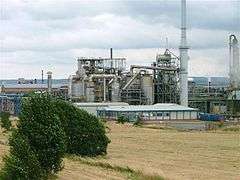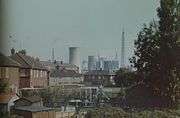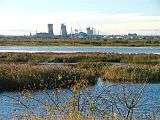Billingham Manufacturing Plant
The Billingham Manufacturing Plant is a large chemical works based in the Borough of Stockton-on-Tees, England. In agricultural terms, it is one of the most important factories in Britain.
| Billingham Manufacturing Plant | |
|---|---|
 Chemical works | |
 Location within County Durham | |
| Former names | Brunner Mond, ICI |
| General information | |
| Type | Chemical works |
| Location | Borough of Stockton-on-Tees |
| Address | Billingham, TS23 1PY |
| Coordinates | 54.59107°N 1.2607°W |
| Elevation | 12 m (39 ft) |
| Landlord | CF Fertilisers UK Limited |

History
Brunner Mond
Ammonia had first been made in Germany in 1913 by BASF at Oppau, near Ludwigshafen (the plant was destroyed in 1921 by the Oppau explosion). Ammonium compounds are not only used for fertilisers, but explosives.
Billingham-on-Tees was a small village in 1917, when its Grange Farm was chosen to be the site of a large chemical works.
On 22 March 1918, the Minister of Munitions approved the site to be developed as a factory that would make ammonium nitrate.[1] It was initially known as the Government Nitrogen Factory – it fixed atmospheric nitrogen.
Brunner Mond took over the works on 22 April 1920, in an agreement with the Minister of Munitions, Andrew Weir, 1st Baron Inverforth. The site was developed (copied) from knowledge of the ammonia plant at Oppau in Germany, and run as Synthetic Ammonia and Nitrates Limited. Other plants copied were at Sheffield, Alabama, La Grande-Paroisse, and one owned by General Chemical near New York.
ICI
In December 1926, ICI was formed from the merger of Brunner Mond, Nobel Explosives, the United Alkali Company and the British Dyestuffs Corporation, largely controlled by Alfred Mond, 1st Baron Melchett, and Harry McGowan, 1st Baron McGowan. By 1932, the plant employed around 5,000 people.
Aldous Huxley visited the works and this gave him the inspiration for his famous 1931 book Brave New World. On the other hand, in the early 1980s, British musician Eric Woolfson paid a visit to the factory having been invited by the then ICI chairman John Harvey-Jones. The first thing Woolfson saw was a kind of street full of pipes where nobody worked, with a sign which said Ammonia Avenue. It would end up being photographed for the front cover for The Alan Parsons Project's seventh studio album, which was also named after the place.[2]
From 1929 the Bergius process was developed to hydrogenate carbon (coal) and make synthetic petrol, with production starting in 1935. This would be needed for aircraft several years later. The Fischer–Tropsch process was used by the Germans during the war to produce synthetic fuel from coal. The RAF's high-performance aircraft needed 100-octane fuel, which was only obtainable from hydrogenated fuels, such as that made at Billingham.[3] Another synthetic fuel (iso-octane) plant at Heysham in Lancashire was built in 1941, where it was thought safer. The synthetic fuel processes at Billingham and Heysham both relied on catalysts for the conversion of the coal synthesis gas to fuel. These catalysts were made in Clitheroe in a plant set up by the government as a shadow factory. Clitheroe being chosen as an area of the UK that has maximum cloud cover so safer than Billingham from being attacked by German bombers.
Second World War
In the Second World War, atomic research also took place on the site, under the codename Tube Alloys, whereby uranium hexafluoride was made. Plastics were also made on the site from 1934,[4] which were used in the construction of aircraft cockpits. The plant also made explosives, as synthetically originated nitrogen compounds (such as trinitrotoluene) all derive from ammonia, due to the immense energetic difficulty in splitting bonds in the nitrogen molecule.
Nuclear reactor
A TRIGA nuclear reactor was developed on the site from 1971 to 1988. Tracerco was developed from this operation, and ICI's Physics and Radioisotope Services.
CF Fertilisers
The plant was sold by ICI to Terra Nitrogen (UK), part of the Terra Nitrogen Company, later purchased by CF Industries and rebranded GrowHow. Growhow is wholly owned by CF Industries, Deerfield, IL USA.[5] GrowHow was rebranded to CF Fertilisers in November 2015.[6]

Structure
It is sandwiched between Belasis Avenue (B1275) and the A1046 in the south-east of Billingham, close to the bank of the River Tees. The A19 runs nearby to the west.
Energy
Natural gas is supplied at between 45 and 65 bar. The site uses around 1% of the UK's natural gas. Electricity comes from its own power station and also from the former North Tees Power Station (which closed in 1983).

Function
It fixates nitrogen, a highly energy-thirsty process, by converting it to ammonia via the Haber process, also known as the Haber–Bosch process. From ammonia, the vast majority of fertilisers are made, leading to protein formation in plants and then animals. Naturally occurring sodium nitrate or potassium nitrate are also used in fertilisers.
See also
- History of fertiliser
- ICI at Wilton
- Billingham Synthonia F.C. – named after the plant's product – synthetic ammonia (synthonia)

References
- Hansard 1925
- "Ammonia Avenue - The Alan Parsons Project". Retrieved 21 May 2019.
- Beesley, E.; Wipp, B. (1953). "Butane dehydrogenation at Billingham". Chem. Ind.(London) (S50): 550–556.
- History of Billingham
- "CF Industries, Inc. - Corporate Profile". www.snl.com. Retrieved 24 September 2015.
- "GrowHow to rebrand as CF Fertilisers UK Ltd". www.CFFertilisers.co.uk. Retrieved 24 August 2017.